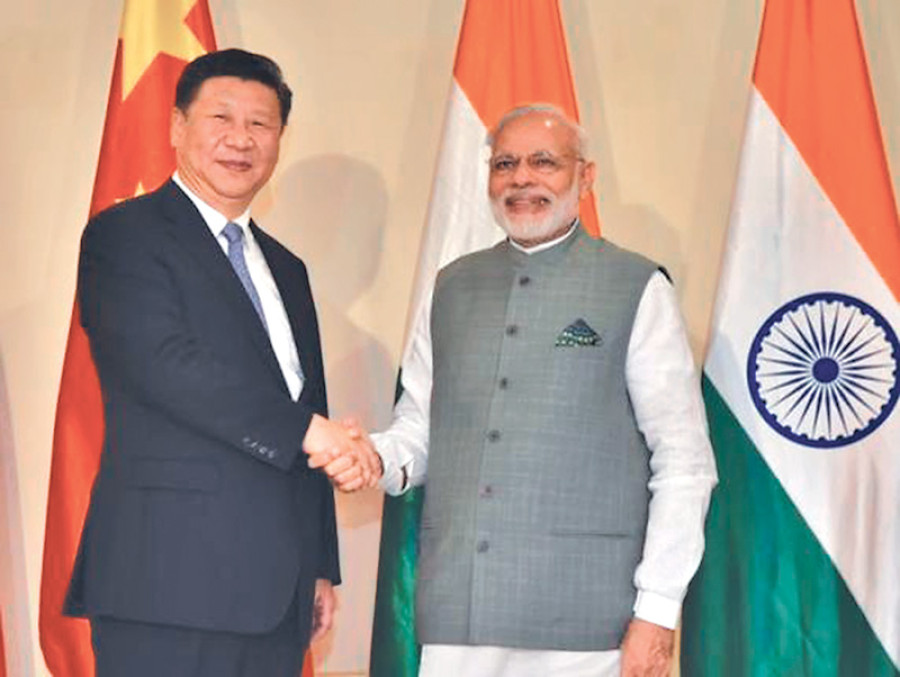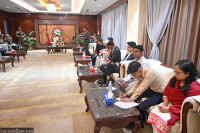Opinion
India meets China in finance
AIIB provides a platform of partnership to India and China away from the border-centric bilateral relations
Mahendra P Lama
The Asian Infrastructure Investment Bank (AIIB), the $100 billion China-led multilateral lender, set up in December 2015 with the membership of 57 countries is the second major Asian initiative after the Asian Development Bank (ADB) established in 1966. The new bank will facilitate investment primarily in energy, transportation, urban construction, logistics, education and healthcare.
Though India has adopted a wait and watch approach towards the Chinese far-reaching “one-belt, one-road” (OBOR) initiative, there are four critical incentives for India to join AIIB as the second largest shareholder in the bank with 7.5 percent of voting shares against China’s 26.06 percent, Russia’s 5.93 percent and Germany’s 4.15 percent. The keenness and seriousness of India, which has a deep infrastructure
deficit, are reflected in its commitment of $8 billion to the AIIB, its inclusion in the bank’s Board of Directors and the appointment of an Indian as a vice president.
Regional integration
First, infrastructure development has been a core issue in India’s development process. It is estimated that it requires at least $1 trillion ($750 billion is required as debt financing) to have a critical minimum level of infrastructure—as against today’s ranking of 87th position out of 144 countries—that will transform India’s economy into a high growth economy of 9 percent.
Although India launched ‘India Infrastructure Finance’ way back in 2006, it is Finance Minister Arun Jaitley who declared infrastructure and investment as the fifth pillar to ‘transform India’. He made a ‘decisive departure’ by allocating an unprecedented total outlay of Rs 2, 21,246 crore (roughly $33 billion) for two critical infrastructure road and railway projects for 2016-17.
Second, India’s robust economy could develop sustainable resilience only if it gets further integrated with the neighbouring regions, including other South Asian nations, and with Asean and East Asian countries. In fact, these regions of economic growth in Asia are themselves hungry for $8 trillion worth of infrastructure projected during 2010-2020 that would generate an income of $13 trillion as stated in ADB-ADBI’s study Infrastructure for Seamless Asia.
The very objective of India’ Act East policy, making its relations with East Asian neighbours a priority, could be realised only with some reliable physical connectivity. Besides the multilateral development institutions like the World Bank and ADB, the engagement of various other bilateral agencies like sovereign wealth funds, Jica from Japan and KfW from Germany and the handing over of projects to widely known private actors like GMR and others from abroad also show that India is ready to deal with multiple partners. Along with newly launched Brics’ New Development Bank (NDB), AIIB now provides a significant degree of flexibility to India.
Concerns about China’s expansion
India unambiguously recognises China as a pivot in global financing. Its Economic Survey 2014-15 states, “today, China has de-facto become one of the lenders of last resort to governments experiencing financial troubles...[It] is assuming the roles of both an International Monetary Fund and a World Bank as a result of its reserves.”
Third, the Chinese encirclement of India’s neighbouring countries with the infrastructure projects like China-Pakistan Economic Corridor has made India rethink its neighbourhood policy. Despite its crucial role, India has not been able to provide meaningful and effective leadership to Saarc.
However, for its connections with South East and Central Asia, the biggest stumbling block is physical connectivity. Yangon, Myanmar’s capital, is hardly a few hundred kilometres from India’s north-eastern states; yet it takes almost a day to reach there via Bangkok. The AIIB could trigger a variety of production networks and make sub-regionalism based interactions prolific and inter-regional integration promising.
Given that six of Saarc’s eight members are signatory to the AIIB and amidst China’s OBOR initiative that literally garlands South Asia with connectivity projects, India has a narrow but far-reaching choice. It does clearly understand the fact that if it really does not participate, it will lag far behind China’s presence in the geographies, societies and economies of this region. In fact, the AIIB has already approved three energy projects in Pakistan and Bangladesh and other two energy projects of India have been proposed.
This could inject newer types of vulnerabilities in India’s neighbourhood. It could change the entire matrices of India’s bilateral relations with its neighbouring countries and could trigger a “new regionalism” exclusively based on connectivity and communication. This could even render regional organisations like Saarc ineffective. Indian economy’s identity and exclusivity could be jeopardised and submerged into the conundrum of hugely connected geographies and emerging socio-economic complexities.
This will happen when neighbouring countries permit China to reach India’s crucial peripheries and borderlands through their borders. In fact India’s Foreign Secretary remarked that it “cannot be impervious to the reality that others may see connectivity as an exercise in hard-wiring that influences choices. This should be discouraged, because particularly in the absence of agreed security architecture in Asia, it could give rise to unnecessary competitiveness. Connectivity should diffuse national rivalries, not add to regional tensions.”
And finally, India’s partnership in the AIIB provides it with an unparalleled opportunity to jointly renegotiate the global financial order and make grounds for steadily reducing ‘diplomatic skirmishes’ and ‘governance deadlock’ with China.
Working in tandem
As the US effectively remains outside the vortex of this new Bank, the AIIB repositions India and China as a driving force towards an ‘Asian Century’. This provides an altogether different platform of partnership to these two competing Asian giants away from the protracted border-centric bilateral disputes of last half a century. This could even inject democracy, foster efficiency and trigger large-scale reforms in Bretton Woods institutions that have a strong pro-North bias.
Unlike these institutions, the AIIB may detach itself from non-economic issues, political influence and other invisible forms of control. Under India’s Act East Policy, a flagship foreign policy programme, it would be connecting to the Asean member countries through modern infrastructure including the India-Myanmar-Thailand trilateral highway. Similarly, the sea port projects in Bangladesh and Sri Lanka and land ports and hydel power projects in Nepal and Bhutan would demand huge investments from India.
India’s Foreign Secretary stated, “We are working to invest in the Chahbahar port, join the Ashgabat Agreement and participate in the International North South Transport Corridor. Combined with other ambitious bilateral initiatives, they could be game changers in Central Asia—a part of the world that historically and culturally has strong affinity with India.”
At the cross-border and regional level, one expects the AIIB funding of Bangladesh-China-India and Myanmar (BCIM) Economic Corridor to which both Indian Prime Minister Narendra Modi and Chinese President Xi Jinping have committed themselves. “The two sides welcomed the progress made in promoting cooperation under the framework of the BCIM (Bangladesh, China, India and Myanmar) Economic Corridor. Both sides recalled the second meeting of the Joint Study Group of BCIM Economic Corridor, and agreed to continue their respective efforts to implement understandings reached at the meeting” The AIIB is inclusive in its face today and in a way has ensured that political hurdles are overcome for cross-border connectivity in the conduct of the flagship OBOR initiative.
Lama, a professor in the School of International Studies, Jawaharlal Nehru University, New Delhi, is the co-author of “Rethinking India-China Borderlands and Security” published by the Michigan University Press. He can be reached at [email protected]




 18.12°C Kathmandu
18.12°C Kathmandu










